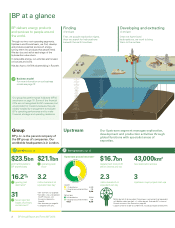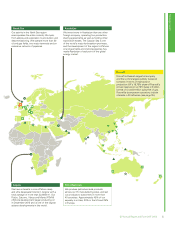BP 2013 Annual Report Download - page 15
Download and view the complete annual report
Please find page 15 of the 2013 BP annual report below. You can navigate through the pages in the report by either clicking on the pages listed below, or by using the keyword search tool below to find specific information within the annual report.
Strategic report
New sources of hydrocarbons are more
difficult to reach, extract and process. BP and
others in our industry are working to improve
techniques for maximizing recovery from
existing and currently inaccessible or
undeveloped fields. In many cases, the
extraction of these resources might be more
energy intensive, which means operating costs
and greenhouse gas emissions from operations
may also increase.
Renewable energy
Renewables will play an increasingly important
role in addressing the challenges of energy
security and climate change over the long term.
Renewables are already the fastest-growing
energy source, but they are starting from a
low base.
By 2035, we estimate renewable energy,
excluding large-scale hydro electricity, is likely to
meet around 7% of total global energy demand.
Energy efficiency and innovation
Greater efficiency addresses several aspects of
the energy challenge. It helps with affordability
– because less energy is needed. It helps with
security – because it reduces dependence on
imports. And it helps with sustainability –
because it reduces emissions.
Innovation can play a key role in improving
technology design, process and use of materials,
bringing down cost and increasing efficiency. In
transport, for example, we believe that efficient
technologies and combustion engines that use
biofuels could offer the most cost-effective
pathway to a secure, lower-carbon future.
Policy, prices and access
If the world’s growing demand for energy is to
be met in a sustainable way, we believe that
governments must set a stable and enduring
framework for the private sector to invest and
for consumers to choose wisely. This includes
secure access for exploration and development
of energy resources, mutual benefits for
resource owners and development partners, and
an appropriate legal and regulatory environment.
We believe open and competitive markets are
the most effective way to encourage companies
to find, produce and distribute diverse forms of
energy sustainably. The US experience with
shale gas shows how an open and competitive
environment can drive technological innovation
and unlock resources.
We also believe that putting a price on carbon
– one that treats all carbon equally, whether it
comes out of a smokestack or a car exhaust –
will make energy efficiency and conservation
more attractive to businesses and individuals
and lower-carbon energy sources more cost
competitive. A global carbon price should
be the long-term goal, but regional and national
approaches are a good first step, provided
temporary financial relief is given to sectors
that are exposed to international competition.
Beyond 2035
We expect that growing population and per
capita incomes will continue to drive growing
demand for energy. These dynamics will be
shaped by future technology developments,
changes in tastes, and future policy choices –
all of which are inherently uncertain. Concerns
about energy security, affordability and
environmental impacts are all likely to be
important considerations. These factors may
accelerate the trend towards more diverse
sources of energy supply, a lower average
carbon footprint, increased efficiency and
demand management.
BP Annual Report and Form 20-F 2013 11
2020
2035
18
16
14
12
10
8
6
4
2
1990 2000 2010
*Includes biofuels.
Source: BP Energy Outlook 2035.
Hydro Coal
Renewables* Nuclear
Oil
Gas
Energy consumption by fuel
(billion tonnes of oil equivalent)
Energy consumption by region
(billion tonnes of oil equivalent)
2020
2035
18
16
14
12
10
8
6
4
2
1990 2000 2010
Source: BP Energy Outlook 2035.
Other ChinaIndia
OECD
Air BP is one of the world’s largest aviation fuels
suppliers, marketing aviation fuels and specialist
products in more than 45 countries. It sells over
seven billion gallons of fuel per year.
See bp.com/energyoutlook.
BP Energy Outlook contains our projections of
future energy trends and factors that could affect
them, based on our views of likely economic and
population growth and developments in policy
and technology. Available in PDF, Excel and video
format.
Strategy
Find out how BP can help meet energy
demand for years to come on page 13.
























